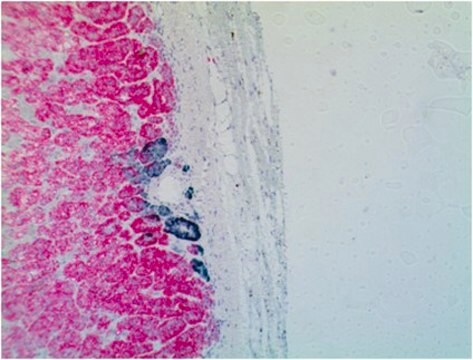ABD29
Anti-Twist1 (Twist-related protein 1) Antibody
from rabbit, purified by affinity chromatography
Sinónimos:
Twist-related protein 1, Class A basic helix-loop-helix protein 38, bHLHa38, H-twist
About This Item
Productos recomendados
origen biológico
rabbit
Nivel de calidad
forma del anticuerpo
affinity isolated antibody
tipo de anticuerpo
primary antibodies
clon
polyclonal
purificado por
affinity chromatography
reactividad de especies
human, rhesus macaque, mouse, horse
reactividad de especies (predicha por homología)
canine (based on 100% sequence homology), pig (based on 100% sequence homology), equine (based on 100% sequence homology), chimpanzee (based on 100% sequence homology), rhesus monkey (based on 100% sequence homology), gorilla (based on 100% sequence homology)
envase
antibody small pack of 25 μg
técnicas
immunocytochemistry: suitable
immunohistochemistry: suitable (paraffin)
Nº de acceso NCBI
Nº de acceso UniProt
Condiciones de envío
ambient
temp. de almacenamiento
2-8°C
modificación del objetivo postraduccional
unmodified
Información sobre el gen
human ... TWIST1(7291)
Descripción general
Especificidad
Inmunógeno
Aplicación
Stem Cell Research
Transcription Factors
Calidad
Immunohistochemistry Analysis: 1:500 dilution of this antibody detected Twist1 in ductal breast fibroadenoma and stratified squamous epithelium and cartilage of human trachea tissues.
Descripción de destino
Forma física
Almacenamiento y estabilidad
Nota de análisis
Ductal breast fibroadenoma and stratified squamous epithelium and cartilage of human trachea tissues
Otras notas
Cláusula de descargo de responsabilidad
¿No encuentra el producto adecuado?
Pruebe nuestro Herramienta de selección de productos.
Opcional
Código de clase de almacenamiento
12 - Non Combustible Liquids
Clase de riesgo para el agua (WGK)
WGK 1
Punto de inflamabilidad (°F)
Not applicable
Punto de inflamabilidad (°C)
Not applicable
Certificados de análisis (COA)
Busque Certificados de análisis (COA) introduciendo el número de lote del producto. Los números de lote se encuentran en la etiqueta del producto después de las palabras «Lot» o «Batch»
¿Ya tiene este producto?
Encuentre la documentación para los productos que ha comprado recientemente en la Biblioteca de documentos.
Nuestro equipo de científicos tiene experiencia en todas las áreas de investigación: Ciencias de la vida, Ciencia de los materiales, Síntesis química, Cromatografía, Analítica y muchas otras.
Póngase en contacto con el Servicio técnico







